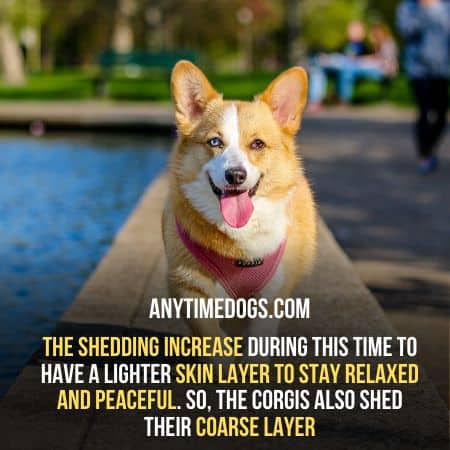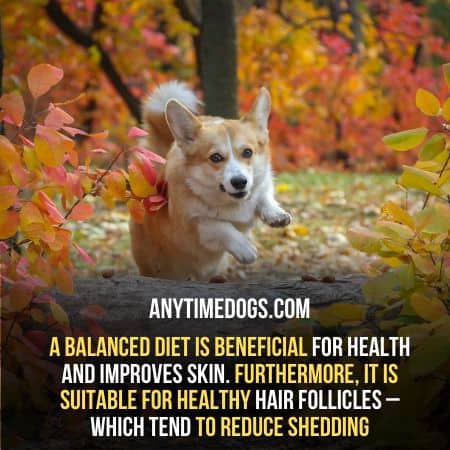Just like Maltese, Goldendoodles, and Chihuahuas shed as they are hypoallergenic. Some people want to know do corgis shed?
Yes, the Corgis shed. Corgis are one of such canines that shed a lot.
Here are some queries on whether Corgis shed a lot or not? Do Corgis shed thought the year? How to manage corgis shedding? What are the reasons for corgis shedding?
Usually, canine breeds that are “hypoallergenic” do shed. However, the frequency of shedding is not the same for all species.
If you are a pet lover and deciding to have a Welsh Corgi, it is excellent. Although, corgis are a little canine breed. These are cute, attractive, and amiable.
But, if you are an allergen to dogs, then Corgi is not a good option. This article will answer all the queries related to corgis shedding.
Dogs shed, but not every breed shed similarly. So, all breeds of Corgi shed differently. But, the critical information is that corgis shed more than any other breed.
The solutions for corgis shedding will be helpful to you to manage the shedding process.
How Frequently Do Corgis Shed?
Corgis shed on regularly, which is not suitable for you if you cannot pay proper attention. However, corgis need adequate care and regular attention.
Corgis shed throughout the year. They shed their furs regularly. The frequency of shedding increases during the summer and winter seasons.
The shedding process is the same for all double-coat canines. Most of the Corgis have medium-sized coats length; so, hair is not easily visible. But, a Corgi with a longer coat has visible shedding.
The Corgis double-layer coat is coarse as it protects from harsh weather conditions. Thus, they shed daily.
Shedding Season: When Do Corgis Shed?
As discussed above, corgis usually shed daily. But, the frequent times of shedding each year are during summer and winter. The term “blowing the coat” is the time when corgis shed during frequent shedding months.
In the winter season, the coat grows thicker to protect them from cold weather. Yet, in summer, the coat sheds to keep canines cool and calm.
During the shedding seasons, you need to give more care time and attention to grooming your Corgi.
8 Primary Causes For Corgis Shedding
It is natural for canines to shed; if your pet does not shed, it might be hairless.
Thus, shedding is the usual process for dogs. Some breeds shed more, and some breeds shed less.
There can be many reasons for Corgis shed. Yet, in this article, 8 significant reasons are:
1) The Corgis Thick Double-Coat:
Pet lovers might know about the pet body, diet, and usual activities. The canine with a thick coat-layer such as a German Shepherd manages the conditions.
Some breeds have thick double coats; it contains two layers a thick top-coat layer and a soft inner layer.

The corgis were bred as herders and faced extreme hot and sometimes extreme cold. So, their thick double-coat layer protects them in such harsh climates.
Either from debris, rain, or any other weather condition. This is the reason for Corgi’s popularity among other canine breeds.
Corgi’s inner coat is like wool. So, it protects your pet as an insulator while the upper-coat layer acts as guard hair.
Here, the thick double-coat is one of the causes of more shedding in pups. The fact is that all the double-coat breeds shed more than single-coat breeds.
2) Corgis Shed Due To Seasonal Changes:
The two significant shedding durations are the reason for Corgis shedding.
You may have noticed that the corgis shed during winter and summers as they adapt to changing seasons.
Shedding depends on the hair cycle routine. In winter, extra protection warms the dogs.
The inner layer of the coat keeps them warm and insulated from freezing temperature. The growth is rapid as in months before winter’s arrival.
Then comes summer, the environment gets warmer, and the need for more growth of hair decreases.

The shedding increase during this time to have a lighter skin layer to stay relaxed and peaceful. So, the Corgis also shed their coarse layer. They start growing a thin layer for the spring season.
This is a cyclical process of shedding among all canines. So you cannot stop your corgis from shedding hair.
3) Stress Can Increase Corgis Shedding:
Stress can be a cause of shedding. Sometimes dogs behave frantically as a result of stress and anxiety.
When any change happens to dogs, it influences their life and routine. Your pet gets more stressed, anxious, and feels lonely.

If anything happens unusual with your puppy, keep in mind to check your dogs. If Corgis shed in the offseason, you should visit a vet for better treatment.
Yet, you can also ensure a thorough check and balance on stress promoters in your Corgi’s life.
The thing that you need to remove from your canine partner’s life. Analyze its behavior, be attentive with its barking, woofing, or other abnormal actions because unusual activities cause stress.
5) Corgis Shed Due To Health Issues:
Normal shedding is usual and good for health. Otherwise, if your Corgi is unhealthy or lazy, it may concern you.
You may get panic due to excessive hair shedding of your Corgi. And it may be alarming to some health problems.
6) Skin Allergies With Corgis:
Another concerning cause for shedding is a skin allergy. It results in skin itching, dryness of skin, and a reason behind extreme shedding.
Yet, allergies may get severe due to many causes. And creates difficulty for corgis.
The 7 significant symptoms for allergies on Corgis skin look like:
- Redness and watery eyes
- Allergies results in Sneezing
- A dog may start scratching.
- Corgi feeling Itchy, and his skin turns red.
- Hairless spots, scabs, or missing fur
- Ears get infected, red, sore.
- Redness on the skin around the toes and legs
7) Hormonal Changes In Female Corgis:
Corgis shedding gets an influence of hormonal changes for a short duration. The hormonal changes keep follicles of hair healthier. Sometimes the hormones become imbalanced due to various reasons:
- Pregnancy in female corgis
- When corgis get neutered or Spayed
- When female corgis are in heat cycles
8) Diet Deficiencies Cause Corgis Shed:
If a Corgi is facing any nutritional deficiency, it may result in serious effects.
Whenever a human lacks diet deficiency, they get physical weakness. Similarly, a dog having a low diet shows laziness, lethargy, and lack of cooperation.
According to a survey, nutritional deficiency is one of the causes of shedding in canine.

Your responsibility is not limited to, providing a dog’s food. Instead, you should give them a proper diet. Add proteins, minerals, vitamins to a diet plan. However, a plantain is useful for indigestion problems.
Your pup may suffer health issues if proper nutrients are missing from the diet. It may result in losing the smooth and silky upper-coat layer. You can add vegetables like cabbage or sprinkle fresh cilantro in their regular food.
A high-quality diet is affordable; it approximately costs around $4 per pound.
When Do Corgis Shed Excessively Except for Shedding Season
You don’t need to worry if your Corgi shed in a routine and regular way. But, if it turns more than usual, consider it a warning.
You should immediately get an appointment with the vet if it is a heavier one. Do revise the activities, diet plan, vibrancy of his coat, and his skin’s health condition.
Corgis breed is one of the heavy shedders. But, excessive shedding is alarming, and your pet has some critical health issues.
Some common issues of abnormal corgis shedding are:
- You are not using a proper dog’s shampoo.
- Lack of enough brushing time with corgis
- A wrong brush may damage corgis skin.
- A Hormonal change appearing in corgis
- Stress, anxiety, and depression.
- Corgis are facing skin infections, parasites, or tumors.
5 Incredible and Workable Remedies: How To Cut Corgis Shedding
If you are conscious about your Corgi’s shedding, then you need to pay attention.
First of all, you have to manage 3 Grooming sessions in a week with your pet. This routine ensures managing shunned hair, keep excessive spreading away from home.
You will have to more careful, observant, and attentive during each grooming session.
Make sure you give them regular brushing at least thrice a week. Use a good shampoo to minimize shedding.
1) Brushing Sessions With Corgis:
One of the most workable methods to control shedding is regular brushing. People have adopted this method to manage the shedding issue.

As you know, Corgis have a double-coated layer. One is the top layer, and the other is the undercoat layer. Most of the time, an undercoat causes excessive shedding in your home.
So, to manage the issue, you brush those loose hair inside the coat. Use a brush that has extended and soft bristles. Therefore, it can easily handle loose hairs deep inside the skin.
2) Give Corgis Weekly Bathing:
Bathing is another useful technique to deal with corgis shedding. You should manage to give a bath to your once between 6 to 10 weeks.
This is helpful to drop unwanted loose and dead hair quickly. Moreover, bathing keeps the layer shiny, soft, and smooth.
However, if you want better results, apply De-shedding shampoo. It slicks hair down and easily removes hair.
You don’t need any particular time for bathing. Just like regular bathing, add de-shedding shampoo.
3) Healthy Diet Stops Corgis, Excessive Shed:
If you love canine, you might know that you can assess your dog’s health from its coat is a good sign of its health.

A balanced diet is beneficial for health and improves skin. Furthermore, it is suitable for healthy hair follicles – which tend to reduce shedding.
Always give a part of quality food to your Corgi. The food should provide essential nutrients, vitamins, and minerals. And do not give them pickles, olives, and marshmallows.
4) Exercise Limit Corgis shed:
Corgis are one of the most charming breeds. They need regular, energetic, and active exercise.
Suppose a Corgi does not get psychical and conceptual exercise. In that case, it can result in a stressful routine and cause extreme shedding.
Therefore, you need to engage them in different exercises. This helps to keep them healthy and active all day long.
5) Regular Visit To Vet Can Be Helpful In Shedding:
This article is all about corgis shedding; Corgi’s good health impacts a good, smooth coat.
As mentioned above, excessive shedding can be due to some severe health problems. A regular visit to the vet will be helpful in this regard.

Regular check-ups are essential if you have a Corgi. It is to protect him from an unhealthy and uncertain condition. This is because shedding increases due to many reasons. So, you should be attentive and alert all time.
Important Prevention Tips For Shedding:
- Use a suitable brush in a circular motion over the upper coat of Corgis.
- Be alert during excessive shedding months.
- Notice shedding spots on the chest, butt, back legs, and neck.
- Once you scan the body, give a final touch to the hair with a brush straight down the length to remove loose clumps of hair.
- For better routine, brush its upper-coat thrice a week.
- Use a de-shedding shampoo with conditioner while bathing.
The De-Shedding Tools For Corgis
There are many De-shedding tools to manage to shed. For grooming sessions, you should have inexpensive and efficient products.
The modest, reasonable, and useful de-shedding tool is essential. You can have the Zoom-Groom tool. It is easy and straightforward to use. Soft bristles of the brush are helpful to remove hair.
ZoomGroom is an inexpensive and effective tool that is a requirement for every pet owner; whoever is facing shedding problems.
You can have many other tools, but you should choose one that gives better de-shedding outcomes.
Conclusion:
The conclusion to do corgis shed is Yes!
The reasons and remedies may help you manage your corgi shedding cycles. Few critical and incredible solutions help to minimize shedding.
You can control corgis shed by applying tips, as mentioned above. No one can tell the accurate shedding duration of the cycle your Corgi may go through.
But an estimate for extreme shedding is between two periods a year – spring and fall.
Though, Corgis do experience good shedding during a year. But, an important thing to keep in mind is, grooming reduces the chances of excessive shedding.

